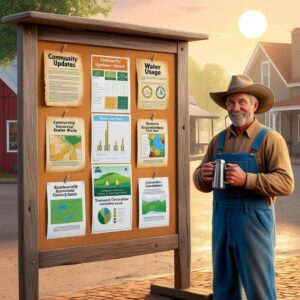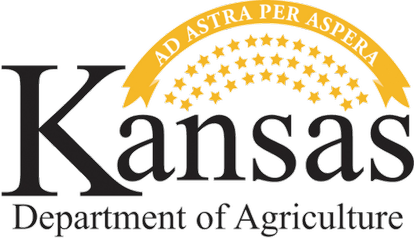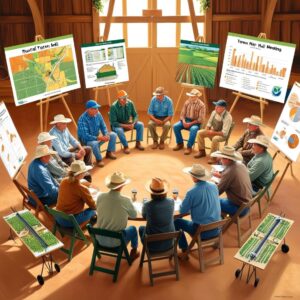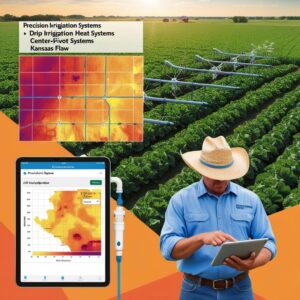Community in Conversation: How Sheridan County, Kansas Communicated Sustainable Change in Water Conservation
 In northwest Kansas, where agriculture and water scarcity go hand in hand, a quiet revolution in irrigation management has been unfolding. Faced with alarming declines in the Ogallala Aquifer—one of the most vital groundwater sources in the U.S.—Sheridan County launched an ambitious initiative to reimagine water use in farming. At the heart of this effort was the Biophysical Agricultural Irrigation Tool for Sustainable Soil and Water Savings (BAITSSS), a high-resolution evapotranspiration (ET) modeling system that has redefined how water conservation and crop productivity can coexist.
In northwest Kansas, where agriculture and water scarcity go hand in hand, a quiet revolution in irrigation management has been unfolding. Faced with alarming declines in the Ogallala Aquifer—one of the most vital groundwater sources in the U.S.—Sheridan County launched an ambitious initiative to reimagine water use in farming. At the heart of this effort was the Biophysical Agricultural Irrigation Tool for Sustainable Soil and Water Savings (BAITSSS), a high-resolution evapotranspiration (ET) modeling system that has redefined how water conservation and crop productivity can coexist.
This case study explores how communication, transparency, and participatory governance fueled the successful implementation of BAITSSS under the Sheridan 6 Local Enhanced Management Area (LEMA) initiative, offering a replicable model for sustainable agriculture across water-stressed regions.
The Initiative: Structure, Purpose, and Technical Foundation
The Sheridan 6 LEMA, established in 2013, was one of the first community-led water conservation zones in Kansas. Under this framework, local farmers voluntarily agreed to reduce water use by 20% over a five-year period—a bold commitment considering the agricultural economy’s reliance on irrigation.
To support this effort with science-based decision-making, the University of Idaho’s Kimberly Research and Extension Center, led by Dr. Ramesh Dhungel, introduced BAITSSS. The model integrates satellite imagery, localized weather data, and soil characteristics to simulate ET and soil moisture at 30-meter spatial and hourly temporal resolutions. The goal: empower farmers with granular, field-level data to fine-tune irrigation schedules and optimize water use without jeopardizing yields.
BAITSSS became more than a tool; it was a shared foundation for data-driven collaboration, trusted by local stakeholders and policymakers alike. It enabled precise monitoring of water usage across fields, setting the stage for credible accountability and informed governance.
A Communication-Centered Approach to Engagement and Behavior Change
From its earliest days, the Sheridan 6 LEMA emphasized communication as the linchpin of its conservation strategy. Rather than imposing restrictions from above, the initiative focused on bottom-up participation, data transparency, and active community dialogue to build trust and commitment.
Community-Led Planning and Messaging
Local farmers served as ambassadors and conveners and, worked closely with Kansas State Research and Extension (K-State) to host listening sessions, where concerns, suggestions, and fears were aired and addressed. These meetings weren’t just check-the-box consultations—they were grounded discussions on how to balance economic viability with ecological responsibility.
Participants shaped the rules themselves, a move that created a sense of ownership over conservation goals. The messaging, delivered by trusted local peers rather than distant officials, reinforced a shared narrative: “We conserve to sustain our way of life.”
Hands-On Education and Technical Literacy
The rollout of BAITSSS included training workshops and demo sessions, facilitated by university researchers and extension agents. These programs helped demystify complex modeling concepts, translating ET maps and irrigation simulations into practical, actionable insights for farmers. The focus was not only on how to use the tool, but why it mattered—linking soil moisture curves to yield resilience and groundwater sustainability.
This hands-on approach to technical communication ensured that farmers didn’t view BAITSSS as an abstract academic instrument but as an accessible tool that strengthened their independence and decision-making.
Transparent Reporting and Public Accountability
BAITSSS wasn’t just used behind closed doors. Its data were shared widely—through presentations, extension bulletins, and community updates—creating an open-data culture that elevated trust and accountability. Stakeholders knew how they were performing relative to conservation targets, and progress was documented in public-facing summaries.
Over time, this transparency became a motivator. Rather than relying solely on enforcement, peer accountability and pride in local leadership drove results.
Modeling Participatory Governance Through Science and Story
The BAITSSS-supported LEMA initiative succeeded not only because of technical sophistication, but because of deep alignment between science, community values, and governance structures.
Science as a Shared Language
BAITSSS provided more than ET calculations—it created a common ground for conversation among farmers, scientists, and policy officials. This data-centric approach shifted debates from anecdotal claims to shared evidence. For example, BAITSSS showed that a 39% reduction in water use was achieved—nearly double the original target—without reducing crop yields.
This combination of empirical credibility and farmer validation gave policymakers confidence to back the initiative and helped skeptics become supporters.
Storytelling and National Visibility
The Sheridan 6 LEMA story gained traction beyond Kansas. National media outlets like NPR and The Wall Street Journal spotlighted the effort, framing it as a homegrown climate adaptation success story. These stories emphasized real people—farmers adjusting irrigation practices, families benefiting from a more secure water future—and helped shift the national conversation from climate fear to climate solutions.
Farmers themselves became storytellers. They spoke at conferences, collaborated with researchers, and lent their voices to extension publications. In doing so, they transformed from passive recipients of policy to co-creators of change.
From Modeling to Movement: Policy Impact and Replication
The impact of BAITSSS and the Sheridan 6 LEMA extends beyond Sheridan County:
- Water Conservation: Over five years, the region reduced groundwater pumping by 39%, preserving the Ogallala Aquifer while maintaining agricultural output.
- Policy Adoption: The Kansas Department of Agriculture and Groundwater Management District 4 used this success to inform other water conservation zones, scaling LEMA concepts to other counties.
- Institutional Trust: The initiative showed that community-driven governance backed by reliable science can outperform top-down mandates.
The initiative is now cited by institutions like the American Association for the Advancement of Science (AAAS) as a model for climate resilience, participatory governance, and agricultural innovation.
Communication Lessons from Sheridan County
The Sheridan 6 LEMA and BAITSSS deployment offer enduring lessons in how strategic communication and stakeholder participation shape environmental policy outcomes:
Communication Builds Legitimacy
Success hinged on local messengers, peer credibility, and iterative feedback loops. Technical tools gained traction only after they were embedded within trusted human relationships.
Education and Literacy Fuel Change
Workshops and plain-language trainings equipped farmers with the knowledge to act confidently. The communication wasn’t just outreach—it was capacity-building.
Transparency Drives Accountability
By publishing BAITSSS data and inviting feedback, the initiative created a feedback-rich ecosystem. Visibility transformed conservation from obligation into collective achievement.
Storytelling Bridges Science and Action
Narratives from the field—delivered to media, decision-makers, and peer networks—humanized the project and inspired others to follow. Sheridan County didn’t just conserve water; it reframed what responsible farming looks like in the 21st century.
 Conclusion
Conclusion
The BAITSSS-supported water conservation effort in Sheridan County exemplifies how technical innovation, community leadership, and clear communication can work hand-in-hand to address environmental challenges. What began as a local experiment in agricultural water savings evolved into a nationally recognized model of collaborative governance.
By blending high-resolution modeling with low-barrier dialogue and education, the Sheridan 6 LEMA empowered farmers not just to conserve—but to lead. This case shows that when communication is treated as a core infrastructure—just like data and policy—the result is resilient systems, credible partnerships, and lasting environmental stewardship.
In a time when water stress, climate pressures, and rural economies are colliding, Sheridan County offers a hopeful roadmap: listen locally, model smartly, and communicate boldly.
Ready to Elevate Your Agency’s Public Communication?
We understand the unique challenges state and local government agencies face—from complex issues to diverse community needs. Our comprehensive approach can help you transform the way you connect with constituents, improve transparency, and highlight the valuable work your agency does every day.
Interested in learning more? Reach out to us today for a consultation. We’d love to discuss how our services can support your goals and help you build lasting trust with the communities you serve.



 Conclusion
Conclusion

